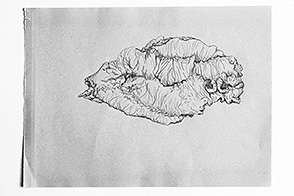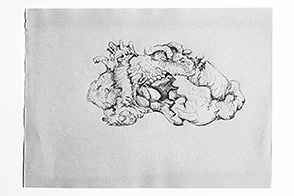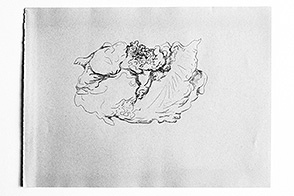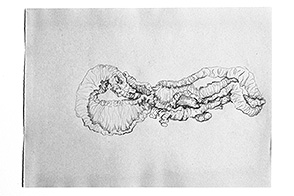



The drawings and texts appear to date from the 1950s to 1970s. The German-Russian doctor had set down his ideas in fragmentary notes, quotations from scientific publications, and sketches in pencil. The small bundle of papers conveys a patchy impression of an unconventional image of the human. There are five pages of fragmentary texts and citations, which are like single bricks for a building that is not clearly defined. I have transcribed the handwritten notes. The drawings, which are all on bluish, rough paper, I used as a basis for the sculptured models.
Here are some of the citations and passages from science and other publications:
The epoch of conscious control of life on Earth.
— N. P. Dubinin, Russian geneticist.
Only if one starts from the basic characteristic of our epoch, the transition of humankind from capitalism to socialism, can the significance of biology for the future of humankind be discussed in its correct context. — R. Löther, philosopher of science.
Life is a highly stable state of matter that, to generate survival responses, utilises information that is encoded by the states of the individual molecules. — A. A. Lyapunov, Sowjetwissenschaft, Gesellschaftswissenschaftliche Beiträge 6 1970.
Life, the mode of existence of an albuminous body, therefore consists primarily in the fact that every moment it is itself and at the same time something else; and this does not take place as the result of a process to which it is subjected from without, as is the way in which this can occur also in the case of inanimate bodies. On the contrary, life, the metabolism which takes place through nutrition and excretion, is a self-implementing process which is inherent in, native to, its bearer, albumen, without which the latter cannot exist. — F. Engels, Herr Eugen Dühring’s Revolution in Science, more commonly known as Engels’ Anti-Dühring, online
The progression of the evolution of life results from inner necessity, the concrete expression of which is the conflictual character of the perpetually transforming biotic relations. — J. M. Olenov, Einige Probleme der evolutionären Genetik und des Darwinismus, Moscow and Leningrad 1961 (in Russian), p. 148.
Some still cleave to the futile hope that all changes, which are observed in an organism during an experiment, are changes within a species. Raphanobrassica (a completely new plant created through artificial polyploidisation of two different genera to create a fertile tetraploid hybrid by G.D. Karpechenko 1928 — author’s note) is a new, hitherto unknown organism; namely, Raphanobrassica. — T. Dobzhansky, Evolution – Genetics – and Man, 1957.
The tempestuous development of science and technology renders the age-old problem of the relationship between humans and nature particularly relevant today. The first socialists were already of the opinion that an important characteristic of the society of the future will be the convergence of humans with nature. — L. I. Brezhnev, 50 Jahre großer Siege des Sozialismus, Berlin 1967, p. 33.
The Hydra of ancient sagas was a beast that was probably invented after the image of the octopus, the polyp, or squid, animals that today zoologists classify as being at the top of the phylum of molluscs, that is, relatively highly developed animals. Hercules, however, fought with a beast that was neither animal nor plant. Only something that was alive. Without a head or extremities, without a distinct form. Not gigantic like the Hydra of sagas in the sense of a singular, gigantic animal body. But gigantic in another sense, that extends beyond the Hydra. when one of its heads was cut off, the Hydra grew two others. The monster that I am referring to tears the warrior apart through a kind of reproductive act whereby billions of new beasts appear beneath his hands. — Wilhelm Bölsche, Vom Bazillus zum Affenmenschen, Jena 1921, p. 3.
Lo, he goeth by me, and I see him not: he passeth on also, but I perceive him not. — Job, 9:11, quotation that J. W. von Goethe placed at the beginning of his Morphologie.
The individual should by no means be understood as something static, but as phasic. An individual as a totality is simply the cycle of the individual. — J. W. Harms, Individualzyklen als Grundlage für die Erforschung des biologischen Geschehens, Berlin 1924, p. 3.
Prometheus saw that all other animals had been wisely provided for; humans, however, were naked, unshod, uncovered, and without weapons, so he stole the ingenious wisdom of Hephaestus and Athena as well as fire, and gave them to humankind (according to Protagoras and Plato — author’s note). How would it be if humankind were relieved of their burden and, without culture and technology, could lead a vegetative and animal existence?
As if thousands of weak-bodied and infirm poets, scientists, inventors, and reformers, together with other thousands of so-called »fools« and »weak-minded enthusiasts«, were not the most precious weapons used by humanity in its struggle for existence by intellectual and moral arms, which Darwin himself emphasised in those same chapters of Descent of Man. — P. Kropotkin, Mutual Aid: A Factor of Evolution, 1902.
Some transcriptions of his hand-written notes:
the parts lying underneath contain much blood, the upper parts contain little blood / firm, mesh-like connective tissue holds the form together / the skin becomes pale in those places where the weight of the body rests on it / mucous membrane interfused with muscle tissue turned inside out / the skin is discoloured greenish by bacteria. Sulfhaemoglobin is produced / organs suffused with gas bubbles / epithelial tissue covers the outer surfaces of the body / inorganic constituents are stored in body tissue / formation of pressure pads of fatty tissue on the underside / lymphoid organs / loss of cartilage as well as intramembranous bone formations / formation as a curved tube / developed as villi / a mesentery / the origins of sack beings / evolutionary changes / partial humans / human sacks / taxonomic group: Homo tubero (swelling human) / evolutionary stage: from Homo erectus to vegetative primate / a result of the process of reducing to basic metabolic physiological activity / the decisive turning point in anthropogenesis with the singular development of the human imago / constant advance of plasma beings / re-organisation of the living human / knowing about the plasmic form of being, however, leads to a new aspect of the organ as organism / the plasmic mode of being does not persist merely in the simple existence of a slimy amoeba or as a discrete plasma entity. Under certain conditions the plasma with its core organs pushes forward to a new form of being, it performs this with an inner power and vehemence: the nuclei form shapes in a higher dimension. In an order that arises in various stages / that the second front of medicine … the form and its development / a new morphology is becoming visible today, which also sets up a new hierarchy of characteristics of life / the classification of plasmic predisposition and mature form achieved … / juvenile stages / to review the developmental steps, which for example allow a heart to develop from the predisposition for a heart / description of the genesis of a body / the destiny of humans is open and they are capable of many possibilities / a special case of anthropogenesis / to separate out from a whole that stretches into infinity / to concentrate our research interest on some specific circumstance of humans / in this way a prevailing mood of the work comes into focus. From it grows the strength to create a new, to co-design / co-form the human, which appears to us to be a central intellectual task of the present / this apparently so simple, semi-transparent … / in optical emptiness (microscopic) / a real neoformation / very deviating variants / also the possibility of initiating such new forms … with which completely new designs arise / in bold forays to advance beyond what can be observed into what has not yet been seen / the ability to generate simplest life forms / the idea of plasma that complicates itself / unconscious life (instead of conscious life) interplay of folding and unfolding / emphasis on the inner organs — predispositions for novel organs / contractions (muscular contractions), neural excitation, sensory abilities, glandular function, sexual appearance, events / the principal anatomical developmental tendencies, which are recognisable, affect the reduction of the head and the extremities and thus the associated loss of bipedal or quadrupedal locomotion and the surrender of manual abilities. … further, a regression of the brain … the leap from the vertebrae to the invertebrates / among the changes that the importance of biological research has wrought in thinking in general and that also seriously influence the concept of a human, the devaluation of consciousness is not the smallest / … to establish emphatically the insight that the extent of conscious experience in the spatial and temporal range of earthly fullness of life is negligible, almost like a dot, that this consciousness only occurs like exiles on tiny islands in an ocean of life which works and toils unconsciously / insights in the complex control of all life processes, which are performed by the disconcerting, for humans incomprehensible power of plasma / the powerful wave action of vegetative existence / life on the way to itself / a form of intermediate life / body parts that assert their independence / that which came together to form a human being, now goes its separate ways / … Humans, in the way that they are, cause too much harm and the … / and see how other ways are possible. / Substance and accident (idea of something). It is or it is not, tertium non datum. all the dualisms. But here something between disembedded interior and exterior. / What habitat do these sack-creatures need? Nutrient solution, soup, ocean, air? / Oneness of inorganic and living nature / individual development and regeneration / living, self-sustaining systems on a human basis / the individual human-like clusters are combined in an organo-coenosis / death is the temporal end of an individual. In humans, death is the transformation into a corpse / natural death is by itself through division of propagating protozoa identical to reproduction and therefore death without a corpse. This unity of death and reproduction should also be made possible for humans.
exhibition: jenseits des menschen / beyond humans
book: jenseits des menschen / beyond humans
Failed Organisms exhibition from 26.11.2009 to 24.1.2010 at the
Laboratoria Art & Science Space
Director Daria Parkhomenko
3 Per. Obukha, 730 0167, m. Chkalovskaya
www.newlaboratoria.ru
Karpov Institute of Physical Chemistry Moscow 105064
Физико-химический научно-исследовательский Институт им. Л.Я. Карпова Russia, 105064, г. Москва, ул. Воронцово Поле, 10

